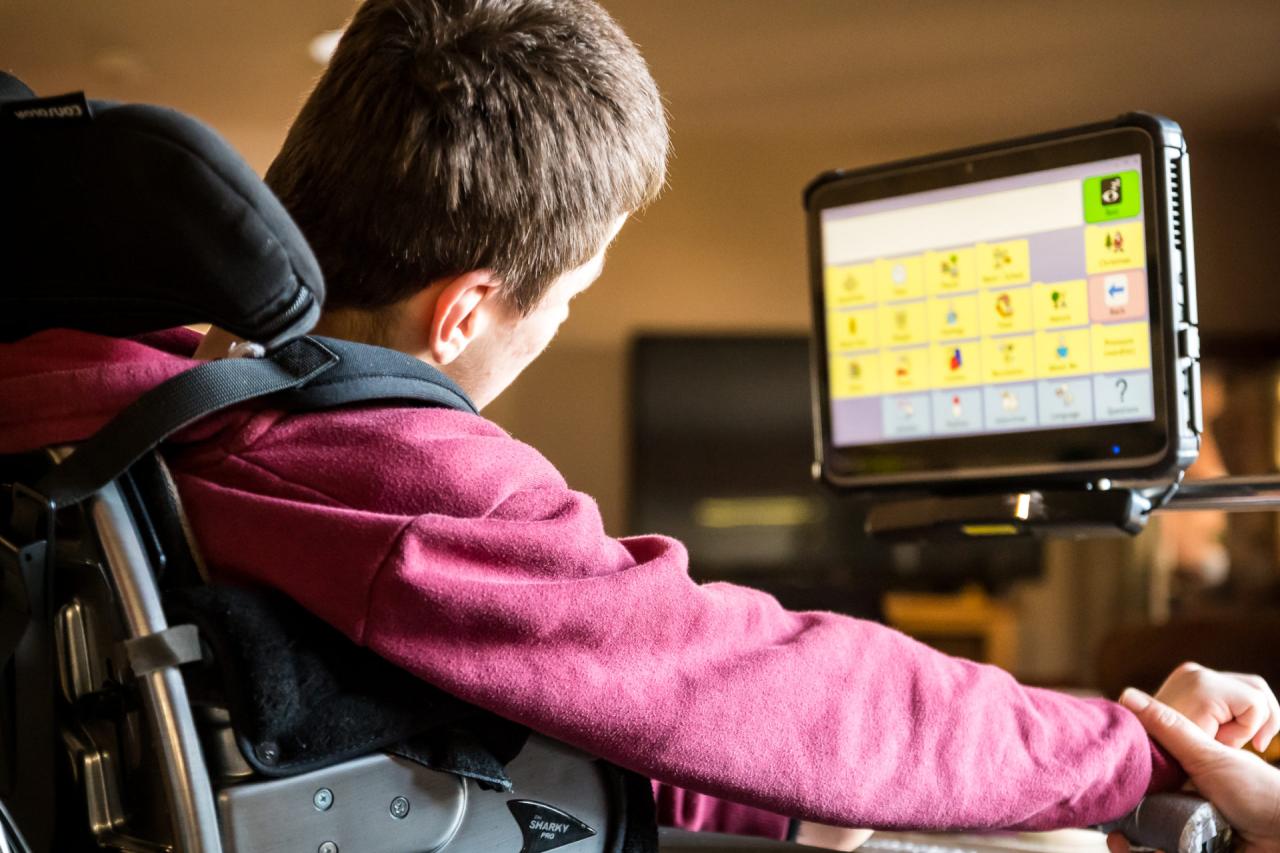Assistive Technology for Traumatic Brain Injury: Enhancing Lives
Assistive technology for traumatic brain injury (TBI) plays a crucial role in empowering individuals to regain independence and improve their quality of life after experiencing this life-altering event. TBI can […]

Assistive technology for traumatic brain injury (TBI) plays a crucial role in empowering individuals to regain independence and improve their quality of life after experiencing this life-altering event. TBI can result in a wide range of challenges, including cognitive impairments, communication difficulties, mobility issues, and difficulties with daily living activities. Assistive technology offers a range of tools and strategies to address these challenges and help individuals with TBI live fulfilling lives.
From cognitive training software and memory aids to communication devices and adaptive utensils, assistive technology provides tailored solutions for specific needs. The use of technology in rehabilitation has also revolutionized the way individuals with TBI receive care, with virtual reality (VR) and augmented reality (AR) applications offering immersive and engaging therapeutic experiences. Furthermore, telemedicine has made it possible for individuals to access remote rehabilitation services and support, expanding access to care and promoting continuity of treatment.
Introduction to Assistive Technology for Traumatic Brain Injury
Traumatic brain injury (TBI) occurs when an external force causes damage to the brain. This can happen due to a variety of factors, such as falls, car accidents, sports injuries, or assaults. TBI can result in a wide range of cognitive, physical, and emotional impairments, affecting an individual’s ability to perform daily tasks, work, and engage in social activities. The severity of TBI can vary greatly, ranging from mild concussions to severe brain injuries.
Assistive technology (AT) plays a crucial role in enhancing the quality of life for individuals with TBI. It provides tools and strategies that help them overcome challenges and participate more fully in their lives. AT can address a wide range of needs, from communication and cognitive impairments to mobility and sensory issues. By utilizing appropriate AT solutions, individuals with TBI can regain lost skills, improve their independence, and achieve their personal goals.
Types of Assistive Technology for TBI Rehabilitation
AT solutions for TBI can be broadly categorized into several types, each addressing specific needs and challenges.
- Cognitive Assistive Technology: These technologies aim to support individuals with cognitive impairments, such as memory problems, attention deficits, and executive function difficulties. Examples include:
- Memory Aids: Electronic organizers, calendars, and reminder apps can help individuals with memory issues stay organized and on track.
- Task Management Software: Software programs can break down complex tasks into smaller, manageable steps, providing guidance and support for individuals with executive function difficulties.
- Cognitive Training Apps: These apps offer exercises and games designed to improve cognitive skills such as attention, memory, and processing speed.
- Communication Assistive Technology: These technologies facilitate communication for individuals with speech and language impairments. Examples include:
- Augmentative and Alternative Communication (AAC) Devices: These devices provide alternative means of communication, such as speech-generating devices, picture exchange systems, and communication boards.
- Speech Recognition Software: This software allows individuals to control their computer or mobile device using voice commands, enabling them to communicate more effectively.
- Mobility Assistive Technology: These technologies aid individuals with physical impairments, such as balance problems, weakness, or paralysis. Examples include:
- Wheelchairs: Wheelchairs provide mobility for individuals with limited walking ability.
- Walking Aids: Canes, walkers, and crutches provide support and stability for individuals with balance issues or weakness.
- Adaptive Equipment: Modified utensils, dressing aids, and other adaptive equipment can make daily activities easier for individuals with physical limitations.
- Sensory Assistive Technology: These technologies assist individuals with sensory impairments, such as visual or auditory deficits. Examples include:
- Magnifiers: Magnifiers can enlarge text and images for individuals with low vision.
- Hearing Aids: Hearing aids amplify sound for individuals with hearing loss.
- Assistive Listening Devices: These devices can improve sound clarity and reduce background noise for individuals with hearing impairments.
Cognitive Assistive Technology for TBI: Assistive Technology For Traumatic Brain Injury

Cognitive impairments are common after a traumatic brain injury (TBI). These impairments can affect a person’s ability to think, learn, and remember. They can also make it difficult to manage daily tasks and participate in social activities. Cognitive assistive technology (CAT) can help people with TBI overcome these challenges and live more fulfilling lives.
Cognitive Impairments After TBI, Assistive technology for traumatic brain injury
Cognitive impairments after TBI can be categorized into different domains, including:
- Memory problems: Difficulty remembering new information, past events, or even personal details. This can include short-term memory loss, long-term memory loss, or problems with retrieving information.
- Attention deficits: Difficulty focusing on tasks, filtering out distractions, or maintaining concentration. This can make it challenging to follow conversations, complete tasks, or stay organized.
- Executive dysfunction: Difficulty planning, organizing, and making decisions. This can impact a person’s ability to manage time, solve problems, or initiate and complete tasks.
- Language difficulties: Challenges with understanding and expressing language, such as difficulty finding words, following conversations, or writing clearly.
- Visual-spatial impairments: Difficulty with visual perception, such as recognizing faces, navigating environments, or interpreting maps.
Assistive Technologies for Cognitive Impairments
Assistive technologies can provide valuable support to individuals with TBI by addressing their cognitive challenges. Some of the most common CATs include:
- Memory aids: These tools help individuals with TBI remember important information. Examples include:
- Electronic organizers: Devices that allow users to schedule appointments, set reminders, and store notes. They can be used to manage daily tasks and keep track of important information.
- Smartwatches: Wearable devices that can provide reminders, track appointments, and even monitor physical activity. They can be particularly helpful for individuals with attention deficits or difficulty remembering daily tasks.
- Apps for medication reminders: Apps that help individuals with TBI remember to take their medications on time. This can be essential for managing their health and well-being.
- Organizational tools: These tools help individuals with TBI organize their thoughts, tasks, and information. Examples include:
- Task management apps: Apps that allow users to create to-do lists, set deadlines, and track progress. They can help individuals with TBI manage their time effectively and prioritize tasks.
- Note-taking software: Software that allows users to take notes, organize information, and search for specific content. It can be particularly helpful for individuals with memory problems or difficulty recalling information.
- Calendar apps: Apps that allow users to schedule appointments, set reminders, and manage their calendars. They can help individuals with TBI keep track of their schedule and avoid missing important appointments.
- Cognitive training software: These programs provide exercises and games that help individuals with TBI improve their cognitive skills. Examples include:
- Brain training apps: Apps that offer a variety of exercises designed to improve attention, memory, and other cognitive skills. These apps can be used independently or as part of a rehabilitation program.
- Software for executive function training: Software that helps individuals with TBI develop skills in planning, organization, and decision-making. These programs can be used to improve daily functioning and increase independence.
- Virtual reality (VR) simulations: VR environments that allow individuals with TBI to practice real-life tasks, such as driving, navigating a grocery store, or managing finances. These simulations can help improve cognitive skills in a safe and controlled environment.
Comparison of Cognitive Assistive Technologies
| Technology | Features | Functionalities | Target Impairments |
|---|---|---|---|
| Electronic organizer | Calendar, notes, reminders, alarms | Schedule appointments, set reminders, store information | Memory problems, attention deficits, executive dysfunction |
| Smartwatch | Reminders, notifications, fitness tracking | Provide alerts, track appointments, monitor activity | Memory problems, attention deficits, executive dysfunction |
| Medication reminder app | Customizable reminders, medication log | Alert users to take medications, track medication history | Memory problems, attention deficits |
| Task management app | To-do lists, deadlines, progress tracking | Organize tasks, prioritize activities, manage time | Executive dysfunction, attention deficits |
| Note-taking software | Text editing, organization, search functions | Take notes, organize information, search for specific content | Memory problems, attention deficits |
| Calendar app | Appointment scheduling, reminders, calendar management | Schedule appointments, set reminders, manage daily schedule | Memory problems, attention deficits, executive dysfunction |
| Brain training app | Games and exercises for cognitive skills | Improve attention, memory, processing speed, and other cognitive skills | Attention deficits, memory problems, executive dysfunction |
| Software for executive function training | Planning, organization, decision-making exercises | Develop skills in planning, organization, and decision-making | Executive dysfunction |
| Virtual reality (VR) simulations | Interactive environments, realistic scenarios | Practice real-life tasks, improve cognitive skills in a safe environment | Attention deficits, memory problems, executive dysfunction |
Wrap-Up
Assistive technology for TBI is an evolving field, with ongoing research and development pushing the boundaries of what’s possible. As technology continues to advance, we can expect even more innovative solutions to emerge, further empowering individuals with TBI to overcome challenges and achieve their full potential. The future of assistive technology holds great promise for improving the lives of individuals with TBI, fostering greater independence, and enabling them to participate fully in all aspects of life.
Assistive technology for traumatic brain injury can range from simple aids like memory aids to more complex devices that help with communication and mobility. One interesting development in this area is the technology jacket , which incorporates sensors and actuators to provide support and assistance for individuals with physical limitations.
These jackets can be tailored to meet specific needs, such as helping with balance or providing gentle reminders for daily tasks. As research in this field continues, we can expect to see even more innovative assistive technology solutions emerge, making a positive impact on the lives of those living with traumatic brain injuries.





